In years to come, it will be rather more difficult to date photos from now by the clothes but images from the past are rather easier as clothes and fashions were generally more date specific. As a rough guide, be aware of TV and film period dramas. Nowadays these programmes are beautifully researched and there is great attention to accuracy. Think about things such as the BBC Pride and Prejudice series or the David Suchet, Hercule Poirot series - Miss Marple - and the clothes that are worn. These notes below would refer to people’s best or most fashionable clothes. Patterns from London were brought to the provinces and copied for the locals for their Sunday best. I don’t want to make this post too long so I have elaborated on some pictures and done notes on others.

A fashion walk through time Pt 1
by Veronica
Have you ever looked at an old family photo and wondered what date it is from? Clothes are probably the best way to give an approximate date for your pictures and paintings.
Acknowledgements
What better source to use than where it all started for me. My beloved Brooke Bond PG tips cards as a child. ! “British costume”. I have used these images which I own but were drawn by a Mr Michael Youens. He copied them from contemporary fashion plates. The photos, as best as I could scan them, are my own photos of my cards.
Acknowledgements also to the Observer’s Book of European dress and the V and A.
 family photo |
Pictures below
1800 – 1820s
This was the time of the Napoleonic wars and cloth was in short supply. Therefore, women’s dresses were narrow and sleeves were short or very narrow to save cloth. Ladies wore little Spencers – a short jacket which finished above the waist. Waist lines were high under the bust-line. Men wore knee britches, frock coats and tricorn hats.
By 1825, cloth was more plentiful. Waistlines dropped to waist level and skirts became fuller. Hats were large and decorated with frills and ribbons. Men were wearing ankle length, tight trousers, frock or morning coats and top hats.
1840s
Dresses in the 1840s had low pointed waists and wide skirts because cloth was more plentiful. Britain had more cloth during peacetime.
Ladies' hair had a parting in the centre with curls and loops down the side. Women wore white caps indoors. Skirts became more voluminous during this time.
Men wore trousers, waistcoats, upstanding collars and ties. Hair was long and men had facial hair rather like Prince Albert, the queen’s husband.
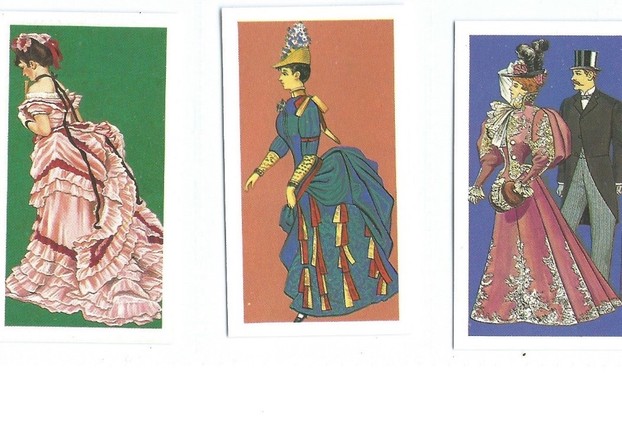 mid 19th C |
Later 19th C
The 1870s and 1880s saw the back of the dress detail become the most important feature with frills, flounces, ruffles, bustles. These have featured a lot in on-site photos. The ladies' hair was worn up in an up-do. Men’s clothes were more like we would see now for men’s daywear, a suit. The long necktie was introduced.
N.B. The Rational Dress Society was founded in 1880 and aimed to make women’s clothes more comfortable. Women wanted to wear divided skirts like trousers. This was felt to be dangerous, and a gross violation of women’s place. It was felt that women may start thinking for themselves and thereby assume men’s roles and behaviour.
1893 saw the start of huge leg o’ mutton sleeves and a narrower skirt. Men wore morning coats or suits. For ladies, the bustle had gone, as had the flounces and ruffles also.
Early 20th C
Pictured here 1901 1909 1916
1901 Ladies had a more sculptured dress with a flatter skirt at the front and large hats. Skirts and white blouses became very fashionable.
1909 Look at the size of the lady’s hat – wider than her shoulders, and how narrow the skirt has become in only 8 years.
1916 Within another 7 years, the lady’s skirt was well above the ankle. This trend had started approx. 1913. For men, the suit was rather more as we would see today but with a longer jacket and high buttoning. The man’s collar was detachable and rounded. The necktie is long. Pointed collars on shirts became fashionable during the late 1920s.
To conclude This is brief but I hope it shows how very different the clothes were. Always look at hair, hats and men’s collars too.
Good luck with your fashion dating and thank you for the interest and constant support.
If you look VERY VERY carefully at the top thumbnail, you will see my Beloved Big Bro, 2nd left standing at the front aged approx 4.
V.
You might also like
Elizabeth Gaskell's House, ManchesterThe famous author's house has been restored not as a museum but as a family h...
19th Century Gothic and Sensation LiteratureGothic Literature or Sensation Literature? What is the difference between the...
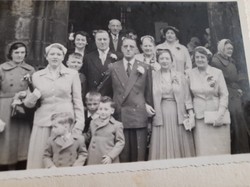


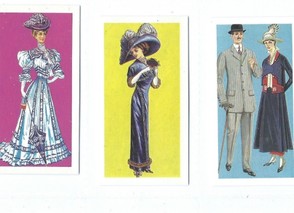

 Blarney Castle and Gardens, County Corkon 06/01/2023
Blarney Castle and Gardens, County Corkon 06/01/2023
 An Cóbh, Corcaigh, Eireon 05/29/2023
An Cóbh, Corcaigh, Eireon 05/29/2023
 Dublin ; The Book of Kellson 04/04/2023
Dublin ; The Book of Kellson 04/04/2023
 The Bee Tree Community CIC;- an online support communityon 08/24/2022
The Bee Tree Community CIC;- an online support communityon 08/24/2022
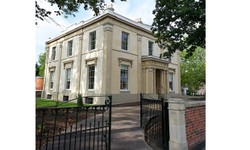
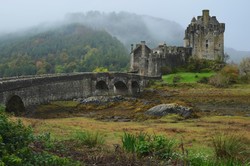
Comments
Your wizzley calls me back again and again with its fashionably historical, historically fashionable configurations.
Some Unitedstatesians especially emphasize the 1940s as the fashion epitome.
The afore-mentioned decade features a clothing article that I particularly favor: the Ike jacket for 38th Unitedstatesian President Eisenhower (Oct. 14, 1890-Mar. 28, 1969).
Might the British Isles ever have had a popular, respected clothing item -- such as Joan the Fair Maid of Kent's garter mustering up the Order of the Garter ;-D -- from someone famous?
DERDRIU
Her talks are absolutely fantastic.
You have a huge capacity for learning and an enquiring mind, so I know you will thoroughly enjoy them. People zoom in from all over the world and she has question sessions at the end where she will answer you .
Thank you, Veronica!
It looks like Lucy Adlington also has written some interesting books. It should be quite rewarding to investigate her online information and her published work.
Who wouldn't like to know more about why we dress the way we do (and do not ;-D)?
Derdriu,
You would absolutely LOVE the History Wardrobe online talks with Lucy , fashion historian. I love her talks. If you log in to them, all your questions will get answered.
Lucy; History wardrobe
Did the material for men's and women's clothes remain the same throughout the 19th century?
Is it possible that the type of material used was related to the socio-economic position of the wearer?
For example, was cotton used in clothing for lower-, middle- and upper-class men and women or was it class-linked? So would silk and velvet perhaps have dominated upper-class wardrobes and cotton or something else have shown up among the lower and middle classes?
BSG
Thanks for your input.
Absolutely right.! there are viewers who will tear the costume departments to threads 0over the slightest mistake! Over here, there are college courses for this profession.
People in the movie industry responsible for wardrobe have to lnow period dress stles, and hairdressers for movies must know period styles. There are professions where this knowledge is necessary, and a desired skill set.
Frank is indeed one of the two boys at the front. He is second left. First left is our next older brother down from Frank !
Is Frank not one of three photogenic boys in the image? If so, who would the other two be?
Did anyone spot my Big Bro above ?